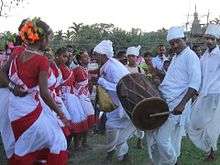Jhumur

Jhumur or Jhumeir (Hindi: झुमर, Nagpuri, Kurmali:Jhumeir, Odia: ଝୁମର, Bengali: ঝুমুর, Assamese: ঝুমুৰ) is a traditional dance of eastern parts of India from State of Jharkhand, Chhattisgarh, Odisha and West Bengal. It is perfermed by Tea-tribes of Assam and Bangladesh.[1] The dance is performed by young girls. They are also accompanied by few male members, who by and large maintain the rhythm with musical instruments and vocals.
Performance
The dance is mostly performed in open places (now-a-days in cultural gatherings also). The male members wear long traditional dresses and keep the rhythm with few traditional instruments: generally a drum, hung on shoulder; a flute and a pair of "Taal" (two metallic discs). The girls mostly perform the dancing part, holding each other's waist and moving hands and legs forward and backward synchronously.
Lyrics
The lyrics of Jhumur are built on day-to-day languages and mostly depict love and or pleasures and pains of day-to-day life.
Locations where performed

Traditionally Jhumur is a folk dance of eastern India like Jharkhand, Chhattisgarh, Odisha and West Bengal. It is performed primarily in an open area like playground or open wide area stage during harvest season or community festivals.
Philosophy
The dance gets its name from the cluster of bells worn round the ankles, which make a clanging noise. There are many variations of Jhumur. This dance is some times performed as a ritual worship of gods and goddesses, sometimes for courting and lovemaking, and yet again as a prayer for rainfall. This dance incorporates songs and dialogues, which depict the joys and sorrows, yearning and aspirations of the everyday lives of the common people. It is believed that Jhumur was originally a means of recreation between phases of tedious agricultural work. Probably the most entertaining form of Jhumur is the Bhaduria, performed as thanksgiving for a bountiful monsoon.[2]
References
- ↑ http://www.maamatimanush.tv/articles.php?aid=624
- ↑ "Folk Jhumur". India heritage. Retrieved 26 February 2011.